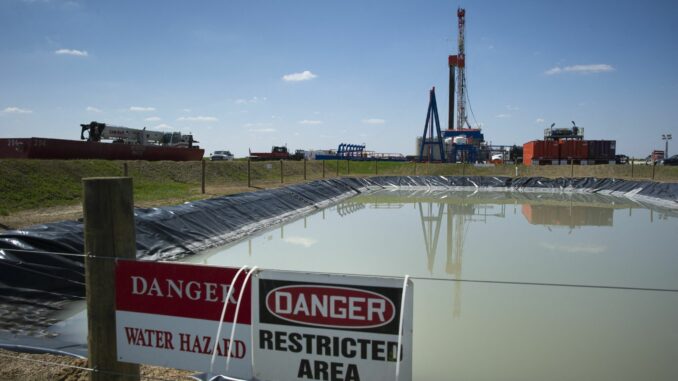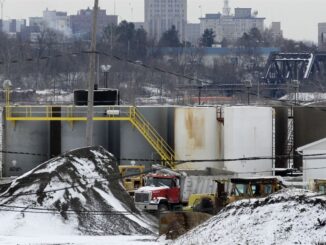
Pennsylvania became the first major fossil fuel-producing state to agree to put a price on carbon last month, when Gov. Tom Wolf’s administration finalized rules to join 11 other states in the northeastern Regional Greenhouse Gas Initiative (RGGI).
But it remains to be seen whether Wolf, a Democrat who is winding down his eight-year term in office, is leaving behind a lasting legacy for climate action, or a last-gasp effort that will be swept aside by foes or one of his would-be successors running in Tuesday’s primary—even one from his own party.
Under RGGI’s “cap-and-invest” design, states agree to set a cap on emissions from their power sectors that declines each year, currently at the rate of 3 percent annually. Power generators buy “allowances” at periodic auctions for each ton of carbon they will emit, with proceeds going to the states to assist in their transition to clean energy.
Because Pennsylvania currently generates more than double the coal power of all other RGGI states combined, its emissions allowances initially will be set at a high level—76 million tons of carbon. With the price of carbon recently reaching a record $13.50 per ton in the RGGI market, Pennsylvania could garner more than $1 billion in its first auction, exceeding the total proceeds brought in by any other RGGI state over the 13 years of the program.
In addition to bringing in revenue, the price is designed to nudge power generators toward choosing carbon-free fuels instead of paying for allowances to emit carbon.
The coal and power industry, labor groups and an agency of the Republican legislature are all in court seeking to block Pennsylvania from joining RGGI. The litigation could delay implementation until the next governor takes office. And as Pennsylvania’s May 17 primary election approaches, it is clear that none of the candidates to replace Wolf—Democratic or Republican—are fans of RGGI. In a state second only to Texas in natural gas production, there is bipartisan skepticism of any policy that could put a damper on fracking.
Pennsylvania’s laborious effort to join RGGI, and the precarious future of its membership in the emissions-cutting club, illustrates the tremendous political pressure that has worked against the multi-state pact throughout its 13-year effort to lower greenhouse gas emissions from electricity. The fossil fuel industry and its allies have fought the program relentlessly, painting it as a hidden energy tax (despite evidence that electricity customers in the region have saved more than $1 billion on their bills). Member states have come and gone as leadership of state capitals changed hands.
Even so, RGGI has had success: Carbon emissions from power plants have been cut 44 percent in the nine states that have participated in RGGI since the beginning, an effect scientists concluded was largely driven by the program. Participating states, meanwhile, have garnered nearly $5 billion in revenue, money they’ve invested in energy efficiency and clean energy projects, assistance to low-income ratepayers and projects to address climate impacts.
Pennsylvania could take in more than $1 billion its first year in the program, while getting on track to reduce up to 225 million tons of carbon pollution by 2030.
“This regulation has the support of businesses and residents, and will save lives and millions of dollars by cutting air pollution,” said Patrick McDonnell, secretary of Pennsylvania’s Department of Environmental Protection, in announcing the final rules. And in words that have an ominous ring, given the legal and political hurdles RGGI still faces in the state, he added, “While Pennsylvania cannot singlehandedly solve the global climate crisis, the world cannot solve the crisis without Pennsylvania.”
Wolf’s RGGI War With the Legislature
Wolf talked about joining RGGI when he first ran for governor in 2014, but it was not a priority during his first term in office, which was marked by brutal budget battles with the Republican-controlled legislature. He was never able to gain traction for his proposal to impose a severance tax on natural gas extraction, which has grown over the past decade to be a major industry in the state thanks to fracking in a large geological formation beneath the Appalachian Mountains, the Marcellus Shale. Pennsylvania is the only major oil and gas producing state without a severance tax. (Instead, drillers pay a smaller impact fee, which mainly goes to county governments.)
After Wolf won reelection in 2018, he launched his drive for Pennsylvania to join RGGI, as the centerpiece of his climate program for the state. But Pennsylvania’s GOP legislature warred with Wolf over RGGI, repeatedly passing laws designed to block the state’s participation—measures that in turn were vetoed by Wolf.
“We’ve got a very recalcitrant, climate-denying fossil-friendly legislature in Pennsylvania,” said Jackson Morris, director of the Natural Resource Defense Council’s eastern region climate and clean energy program. “The legislature has exhausted every parliamentary stunt that they have, and they just don’t have the votes to override the veto from the governor.”
While other RGGI states passed new laws enabling their entry into the program, Wolf’s administration used Pennsylvania’s existing environmental laws to design a plan for the state’s entry into the program. The state DEP held 10 public hearings and garnered 14,000 public comments on the plan. Based on its analysis of the information it had gathered, the Wolf administration projected that participation in RGGI would increase Pennsylvania’s Gross State Product by nearly $2 billion, and result in a net increase of 30,000 jobs by 2030.
Even though Pennsylvania has not been a part of RGGI, carbon emissions from electricity in the state have fallen a third since 2009. The market has been prodding the industry in the direction of cleaner energy, because coal is more expensive than the alternatives. The most recent modeling by the state DEP shows that with or without RGGI, all of Pennsylvania’s remaining conventional coal plants are uneconomic and likely to close by 2025. That means the biggest change that RGGI’s price on carbon is likely to spur in the Pennsylvania power sector is a switch from natural gas to carbon-free alternatives—renewable energy and the state’s existing nuclear power fleet, as well as energy efficiency.
“Joining RGGI is, hands down, the most significant climate policy action taken in Pennsylvania’s history,” said Morris.
But natural gas, which now fuels more than half of Pennsylvania’s electricity, is a business with political allies in both parties.
Source: Insideclimatenews.org



